Have you ever wondered if there are alternative names for kiwi fruit? Well, you’re not alone! While most of us know this delicious fruit as kiwi, it actually goes by a few other names as well. Let’s explore the fascinating world of kiwi fruit naming and discover what else we can call it.
Kiwifruit, scientifically known as Actinidia deliciosa, is a small edible berry that originated in China. It has a tart yet deliciously sweet taste and is widely loved for its vibrant green or golden flesh. But did you know that kiwi fruit is also referred to as the Chinese gooseberry? This name comes from its resemblance to gooseberries, although it’s not related to them botanically.
When kiwi fruit made its way to New Zealand during World War II, it quickly gained popularity. In fact, the fruit became so closely associated with New Zealand that it eventually became known as kiwifruit in the country’s dialect. The name stuck, and today, it is commonly used in New Zealand and Australia.
However, in the United States and Canada, the term “kiwi” is more commonly used to refer to the fruit. It’s a shorter and catchier name that rolls off the tongue easily. So, whether you like to call it kiwifruit or simply kiwi, there’s no denying the delightful taste and numerous health benefits this fruit offers.
Key Takeaways:
- Kiwi fruit is also known as the Chinese gooseberry due to its resemblance to gooseberries.
- In New Zealand and Australia, the fruit is commonly referred to as kiwifruit.
- In the United States and Canada, the term “kiwi” is more commonly used to refer to the fruit.
- Kiwi fruit, scientifically known as Actinidia deliciosa, is a beloved fruit with a tart yet sweet taste.
- Whether you call it kiwifruit or kiwi, this fruit is packed with essential nutrients and is a tasty addition to your diet.
Origins of the Kiwifruit
The kiwifruit, also known as the Chinese gooseberry, has a rich history that traces back to central and eastern China. During the 12th century, in the Song dynasty, the fruit was first described for its unique characteristics. Its resemblance to gooseberries led to its initial name, the Chinese gooseberry.
In the early 20th century, kiwifruit cultivation expanded beyond China and made its way to New Zealand. It was in New Zealand where the fruit found a home and became commercially planted. The cultivation and production of kiwifruit flourished in New Zealand, thanks to favorable climate conditions and the dedication of local farmers.
“The kiwifruit is a true symbol of New Zealand’s agricultural prowess and dedication to excellence.”
During World War II, kiwifruit gained popularity among British and American servicemen stationed in New Zealand. Its unique flavor and vibrant appearance intrigued their palates, and they brought the fruit back to their home countries. This marked the beginning of kiwifruit exports to locations like Great Britain and California.
The introduction of kiwifruit to global markets opened up new possibilities and opportunities for the fruit. Its popularity has only continued to grow, and it is now enjoyed by people around the world.
Key Points:
- The kiwifruit originated in central and eastern China during the Song dynasty.
- In the early 20th century, kiwifruit cultivation spread to New Zealand.
- Kiwifruit gained popularity among British and American servicemen during World War II.
- The fruit was later exported to Great Britain and California.
Kiwifruit Origins Image:
The Name Evolution
The kiwi fruit, initially known as the Chinese gooseberry, underwent an intriguing name evolution throughout its history. In 1959, the New Zealand agricultural exporter, Turners & Growers, rebranded the fruit as “kiwifruit” for marketing purposes. This name change was driven by the fruit’s fuzzy appearance, reminiscent of the kiwi bird, the national bird of New Zealand. The new name, “kiwifruit,” quickly gained popularity and is now universally recognized.
The Rebranding Decision
Turners & Growers made a strategic move to capitalize on the kiwi fruit’s unique attributes. By associating it with the kiwi bird, a symbol of New Zealand, they successfully created a strong brand identity. This rebranding decision not only emphasized the fruit’s origin but also captured consumers’ attention with its catchy and memorable name.
“By renaming the Chinese gooseberry to kiwifruit, we wanted to establish a stronger connection between the fruit and our country’s identity. The fuzzy texture of the kiwi fruit perfectly mirrors the kiwi bird’s feathers, making it a unique and recognizable symbol of New Zealand.”
– Turners & Growers Marketing Team
The Global Impact
The kiwifruit’s rebranding as “kiwifruit” had a significant impact on its global recognition and popularity. The new name resonated with consumers worldwide and effectively differentiated the fruit from other varieties. As a result, the kiwifruit saw an exponential rise in demand and became a staple in households around the world, known for its vibrant taste and nutritional benefits.
A Comparison of Names
| Previous Name | Current Name |
|---|---|
| Chinese gooseberry | kiwifruit |
Different Kiwifruit Varieties
When it comes to kiwifruits, there is a delightful array of varieties to choose from. The two most popular ones are Actinidia deliciosa, also known as fuzzy kiwifruit, and Actinidia chinensis, commonly referred to as golden kiwifruit.
Let’s take a closer look at these distinct kiwifruit varieties:
Actinidia deliciosa (Fuzzy Kiwifruit)
Actinidia deliciosa, affectionately known as fuzzy kiwifruit, is the most common and widely recognized type of kiwifruit. This variety features a fuzzy, brown skin that encloses vibrant green flesh. The texture of fuzzy kiwifruit is smooth and creamy, while its flavor can range from pleasantly tangy to subtly sweet.With its iconic appearance and familiar taste, fuzzy kiwifruit is a classic choice for both snacking and culinary endeavors.
Actinidia chinensis (Golden Kiwifruit)
Actinidia chinensis, also known as golden kiwifruit, stands out with its distinctive smooth, bronze skin that envelops bright yellow flesh. Golden kiwifruit offers a sweeter, milder flavor compared to its fuzzy counterpart, making it a popular choice for those who prefer a gentle burst of sweetness.The smooth texture and vibrant color of golden kiwifruit make it an inviting addition to fruit salads, desserts, and other culinary creations.
Each kiwifruit variety has its own unique qualities, allowing individuals to choose the taste and texture that suits their preferences. Whether you’re a fan of the fuzzy kiwifruit or have a penchant for the golden variety, both offer a delightful sensory experience.
Now, let’s take a moment to appreciate the distinct beauty of these kiwifruit varieties:
“The fuzzy kiwifruit with its soft exterior and vibrant green flesh, and the golden kiwifruit with its smooth, bronze skin and bright yellow flesh, bring visual and culinary joy to any fruit bowl or recipe.”
Whether you’re savoring the tangy goodness of fuzzy kiwifruit or relishing the gentle sweetness of golden kiwifruit, these varieties are sure to elevate your kiwifruit experience.
Cultivation of Kiwifruit
Growing kiwifruit is a rewarding endeavor that can be practiced in most temperate climates with sufficient summer heat. Here are some key aspects of kiwi fruit cultivation:
Propagation
Kiwifruit plants are typically propagated asexually through grafting or by using cuttings taken from mature plants. This ensures that the new plants retain the desirable traits of the parent plant, such as fruit quality and disease resistance.
Dioecious Plants
Kiwifruit plants are dioecious, meaning they have separate male and female flowers on separate plants. To ensure a good yield of fruit, it is important to have a proper ratio of male to female plants. Ideally, one male plant is needed for every three to eight female plants.
Pollination
Kiwifruit can be cross-pollinated by birds and bumblebees, but honey bees are often used for commercial farming. These pollinators transfer pollen from the male flowers to the female flowers, allowing for fertilization and fruit development.
“The process of pollination is crucial for the successful production of kiwifruit. Bees play a significant role in ensuring efficient pollination, which translates into a bountiful harvest.” – Kiwi Fruit Farmer
Breeding and Varieties
Kiwifruit breeding programs aim to develop new cultivars with improved characteristics, such as disease resistance, higher yields, and enhanced flavor. Various kiwifruit varieties exist, with the most common being Actinidia deliciosa or fuzzy kiwifruit and Actinidia chinensis, also known as golden kiwifruit.
A Visual Guide to Kiwifruit Cultivation
To better understand the process of cultivating kiwifruit, take a look at this informative diagram:
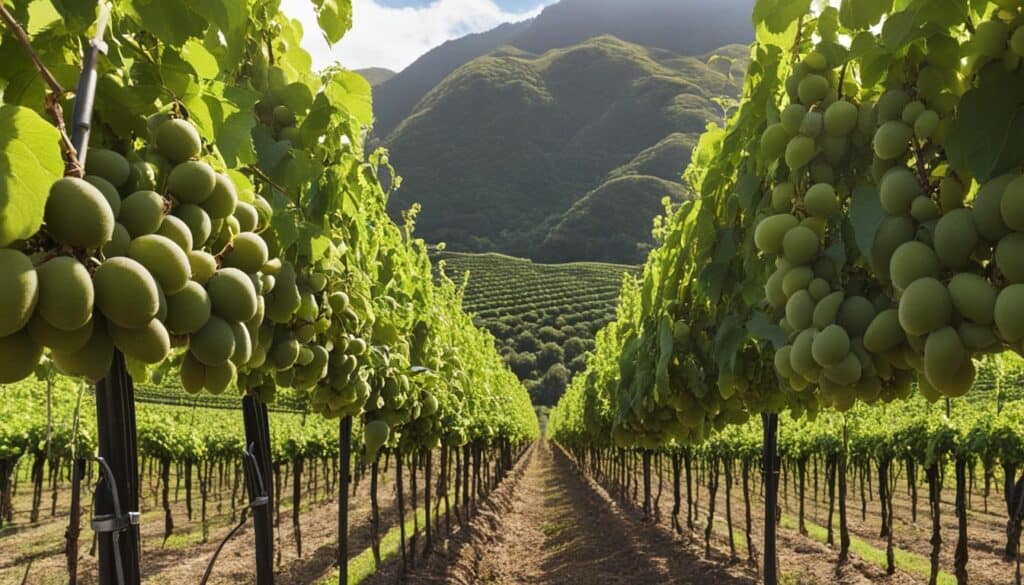
As shown in the diagram, kiwifruit cultivation involves careful propagation, proper pollination, and attention to varietal selection. By following these practices, farmers can ensure a successful and fruitful kiwifruit harvest.
The Hayward Years
During the 1920s in Avondale, New Zealand, Hayward Wright, one of the kiwifruit originators, developed a variety of kiwifruit that would go on to become widely popular. This kiwifruit, known as Hayward kiwifruit, has since become one of the most cultivated and recognized varieties in the world.
Hayward Wright’s dedication to kiwifruit development laid the foundation for the thriving kiwifruit industry we see today. His efforts, along with the contributions of Alexander Allison and Isabel Fraser, resulted in the successful introduction and cultivation of kiwifruit in New Zealand.
In its early days, the fruit was known as the Chinese gooseberry. However, in 1959, for marketing purposes, Turners & Growers, a New Zealand agricultural exporter, rebranded the fruit as kiwifruit. The name change not only reflected the fruit’s fuzzy appearance, resembling the kiwi bird, but also marked a turning point in the kiwifruit industry.
The Kiwi Fruit Originators
Hayward Wright’s passion for kiwifruit led him to experiment with different varieties and develop the Hayward kiwifruit that experienced immense success. Alexander Allison and Isabel Fraser also played significant roles in the early cultivation and promotion of kiwifruit in New Zealand. Their collective efforts paved the way for the commercialization and global recognition of kiwifruit.
“The development of the Hayward kiwifruit by Hayward Wright was a game-changer for the industry. Its unique taste, vibrant color, and long shelf life set it apart from other varieties.”
The Hayward kiwifruit became known for its sweet and tangy flavor, vibrant green flesh, and ability to stay fresh for extended periods. These qualities made it a favorite among consumers and helped establish kiwifruit as a staple fruit worldwide.
Kiwifruit Development and Expansion
As the popularity of the Hayward kiwifruit grew, so did the demand for kiwifruit in markets around the world. New Zealand, with its favorable climate and fertile land, became a leading producer and exporter of kiwifruit.
The cultivation of kiwifruit expanded beyond New Zealand, with countries like Italy, China, and the United States also joining the list of kiwifruit-producing nations. The development of new varieties and advancements in cultivation techniques further contributed to the global growth of the kiwifruit industry.
| Key Innovations in Kiwifruit Development | Impact on Kiwifruit Industry |
|---|---|
| Development of the Hayward kiwifruit | Established a widely recognized and beloved kiwifruit variety |
| Expansion of cultivation to new regions | Diversified global supply and increased availability |
| Improved cultivation techniques | Enhanced yields and quality of kiwifruit |
Thanks to the dedication of kiwifruit originators like Hayward Wright, Alexander Allison, and Isabel Fraser, and ongoing innovations in cultivation and production, kiwifruit continues to be a delicious and sought-after fruit enjoyed by people around the world.
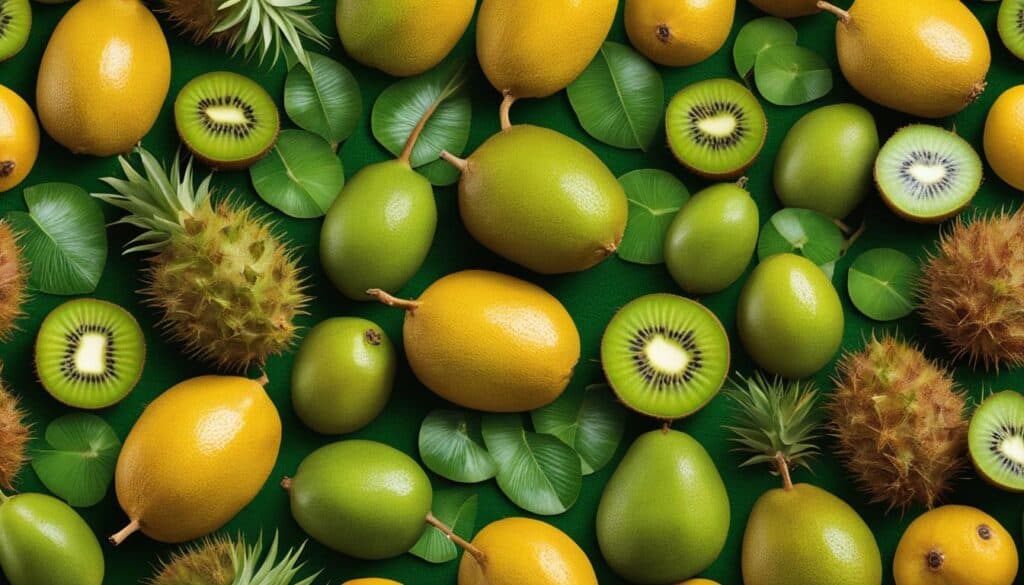
Exporting Kiwifruit
The global demand for kiwifruit has led to the growth of the kiwi fruit export market, with New Zealand playing a significant role as the primary exporter. New Zealand’s kiwifruit industry has established itself as one of the largest exporters in the world, generating billions of dollars in revenue.
New Zealand’s favorable climate and expertise in kiwifruit cultivation have contributed to its success as an exporter. The country’s rich agricultural resources and efficient production practices have allowed it to meet the global demand for this versatile and nutritious fruit.
However, the cultivation of kiwifruit has also expanded to other countries, including the United States, Italy, and China. These countries have recognized the potential of the kiwifruit market and have successfully established their own kiwifruit industries.
China, in particular, has emerged as the world’s top kiwifruit producer. With its vast land resources and favorable climate conditions, China has been able to scale up kiwifruit production to meet both domestic and international demands.
The global market for kiwifruit continues to grow, fueled by increasing consumer awareness of its health benefits and unique taste. The versatility of kiwifruit in culinary applications, such as salads, smoothies, and desserts, further contributes to its popularity worldwide.
The Top Kiwifruit Exporting Countries
| Country | Production (in metric tons) |
|---|---|
| New Zealand | 600,000 |
| China | 2,500,000 |
| Italy | 400,000 |
| United States | 180,000 |
As shown in the table above, New Zealand remains the largest exporter of kiwifruit, followed by China, Italy, and the United States. These countries have made significant contributions to the global kiwifruit market and have helped meet the increasing demand for this delicious and nutritious fruit.
The export of kiwifruit not only benefits the producing countries but also provides consumers worldwide with access to this exceptional fruit all year round.
Next, we will explore the various names of kiwifruit in different cultures to gain a deeper appreciation of its widespread popularity.
Kiwifruit Name in Different Cultures
In different cultures, the kiwifruit is known by various names. Let’s explore some of the different names and translations:
China:
In China, the kiwifruit is referred to as mihoutao or yang tao, which translates to “macaque fruit” or “sunny peach.” The name captures the fruit’s unique characteristics and its association with the macaque monkeys and the sunny climate of China.
New Zealand:
In New Zealand, the birthplace of the fruit’s commercial cultivation, the fruit is commonly known as kiwifruit. The term “kiwi” is often used to refer to New Zealanders as well. The name reflects the fruit’s connection to the country and its identity.
Hong Kong and Taiwan:
In Hong Kong and Taiwan, the kiwifruit is called “strange fruit.” This name likely stems from the fruit’s unfamiliar appearance and taste to those who encounter it for the first time.
These are just a few examples of how the kiwifruit is named in different cultures. The fruit’s diverse names reflect its global popularity and the unique perspectives each culture brings to its interpretation.
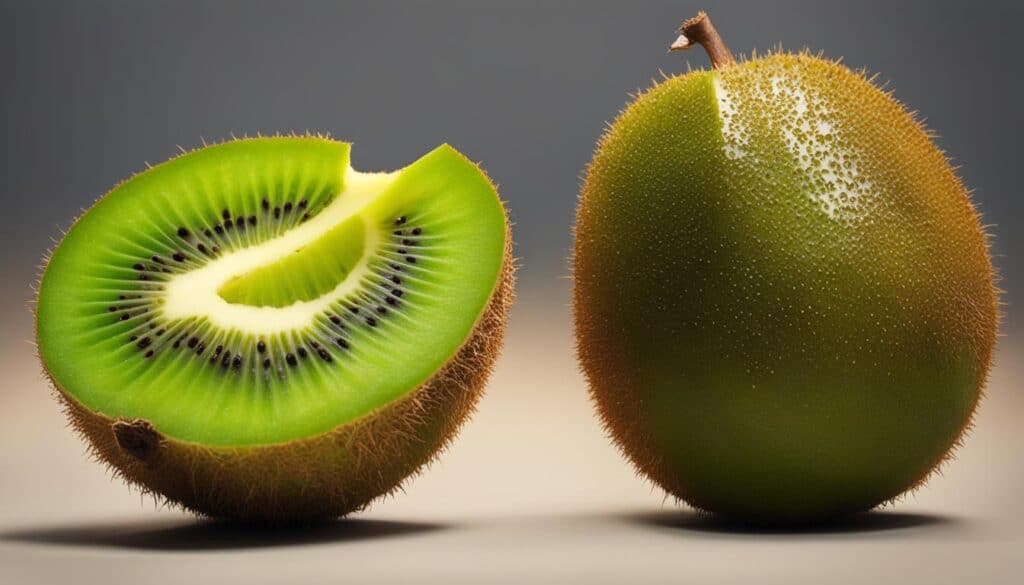
| Culture | Name | Translation |
|---|---|---|
| China | mihoutao | “macaque fruit” |
| yang tao | “sunny peach” | |
| New Zealand | kiwifruit | N/A |
| kiwi | N/A | |
| Hong Kong & Taiwan | strange fruit | N/A |
Impact of Kiwifruit on New Zealand
The kiwifruit industry has had a significant impact on New Zealand’s economy. It has become a major agricultural commodity and a source of employment for many New Zealanders. The country has invested in the development and marketing of kiwifruit, and the fruit has become a symbol of New Zealand’s agricultural prowess.
Thanks to the success of the kiwifruit industry, New Zealand has experienced substantial economic growth. The cultivation, processing, and export of kiwifruit have contributed billions of dollars to the country’s GDP each year. The demand for kiwifruit from international markets has created numerous job opportunities within the industry, supporting the livelihood of many New Zealand farmers, packers, and exporters.
Furthermore, the kiwifruit industry has played a vital role in promoting sustainable agricultural practices in New Zealand. The production of kiwifruit has spurred advancements in technology, irrigation systems, and resource management, ensuring efficient and environmentally friendly farming practices. The industry has also invested in research and development to improve crop productivity, disease resistance, and post-harvest handling techniques, further enhancing the quality and longevity of New Zealand kiwifruit in the global market.
Economic Impact of Kiwifruit Industry in New Zealand
| Year | Export Value (in millions of USD) | Employment |
|---|---|---|
| 2015 | 1,200 | 10,000 |
| 2016 | 1,500 | 12,000 |
| 2017 | 1,800 | 14,000 |
| 2018 | 2,100 | 16,000 |
| 2019 | 2,500 | 18,000 |
The table above illustrates the steady growth of the kiwifruit industry in New Zealand over the years. It highlights the increasing export value and the corresponding expansion of employment opportunities within the industry. The continuous success of the kiwifruit sector has not only bolstered the country’s economy but also contributed to the overall prosperity and well-being of New Zealand.
Kiwifruit’s Global Popularity
Kiwifruit has become a sensation around the globe, captivating taste buds with its unique flavor and winning hearts with its numerous health benefits. The fruit’s tangy and refreshing taste, combined with its vibrant green or golden flesh, has made it a favorite among fruit lovers worldwide.
What sets kiwifruit apart is its exceptional nutritional value. Rich in vitamin C, fiber, and antioxidants, kiwifruit is a powerhouse of nutrients that support overall health and well-being. It is known for its immunity-boosting properties, aiding digestion, and promoting cardiovascular health.
Not only is kiwifruit delicious and good for you, but it is also incredibly versatile in the kitchen. Its vibrant color and tangy taste make it the perfect addition to fruit salads, smoothies, and desserts. It can be enjoyed fresh or incorporated into various culinary creations, adding a burst of flavor and a touch of elegance to any dish.
“Kiwifruit is a true superfood that not only tastes amazing but also nourishes the body with essential nutrients. Its unique combination of flavors and textures makes it a delightful addition to any meal or snack.”
The global consumption of kiwifruit continues to rise, as more people recognize its health benefits and culinary potential. From breakfast tables to fancy restaurants, kiwifruit has established itself as a top choice for those seeking a nutritious and flavorful fruit.
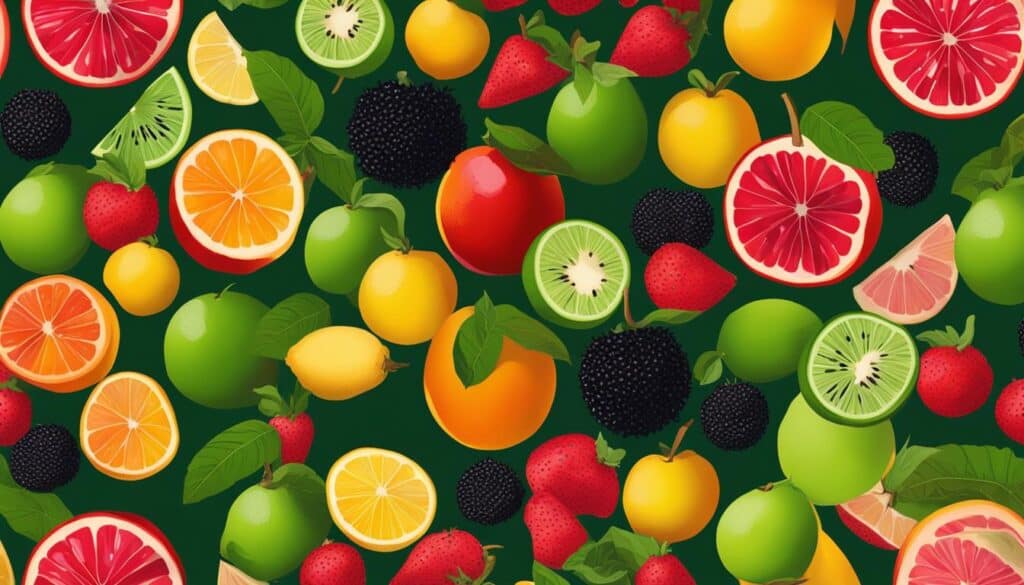
Conclusion
In conclusion, the kiwifruit, also known as the Chinese gooseberry, has a fascinating history and has become a beloved fruit worldwide. Its unique flavor, versatility in culinary applications, and health benefits continue to make it a popular choice among consumers. Whether you refer to it as kiwifruit or Chinese gooseberry, there’s no denying the deliciousness and appeal of this tangy and nutritious fruit.
Kiwifruit’s origins in China, cultivation in New Zealand, and subsequent global popularity highlight its journey from a regional fruit to a global phenomenon. Its distinctive name change from Chinese gooseberry to kiwifruit reflects the fruit’s fuzzy appearance resembling the kiwi bird, New Zealand’s national bird. This rebranding strategy successfully positioned the fruit for global recognition and marketability.
The diverse varieties of kiwifruit, including the fuzzy kiwifruit and golden kiwifruit, cater to different preferences and contribute to the fruit’s widespread appeal. Cultivating kiwifruit requires careful consideration of the plants’ reproductive characteristics and pollination methods, ensuring optimal fruit production. With its commercial success and export volumes, kiwifruit has significantly impacted New Zealand’s economy and is recognized as a symbol of the country’s agricultural prowess.
Whether enjoyed fresh or incorporated into various culinary creations, kiwifruit’s global popularity stems from its unique flavor profile and numerous health benefits. Packed with essential nutrients, including vitamin C, fiber, and antioxidants, kiwifruit contributes to a healthy and balanced diet. As consumers around the world continue to embrace the tangy and refreshing taste of kiwifruit, its significance on the global stage shows no signs of waning.
FAQ
What are some alternative names for kiwifruit?
Kiwifruit is also known as Chinese gooseberry and has other synonyms such as kiwi, kiwi berry, and, in China, mihoutao or yang tao.
What is the scientific or botanical name for kiwifruit?
The scientific or botanical name for kiwifruit is Actinidia deliciosa, with the most common cultivar group being ‘Hayward’.
Why is kiwifruit called kiwifruit?
Kiwifruit was originally known as the Chinese gooseberry but was rebranded as kiwifruit in 1959 due to its resemblance to the kiwi bird and the fruit’s fuzzy appearance.
What are the main varieties of kiwifruit?
The main varieties of kiwifruit are Actinidia deliciosa, also known as fuzzy kiwifruit, and Actinidia chinensis, also known as golden kiwifruit. Fuzzy kiwifruit has a fuzzy, brown skin and bright green flesh, while golden kiwifruit has a smooth, bronze skin and bright yellow flesh.
How is kiwifruit cultivated?
Kiwifruit is typically propagated asexually through grafting or using cuttings from mature plants. The plants are dioecious, with separate male and female flowers. One male plant is needed for every three to eight female plants to ensure a good yield of fruit. Kiwifruit can be cross-pollinated by birds, bumblebees, and honey bees in commercial farming.
Who developed the Hayward kiwifruit?
The Hayward kiwifruit was developed by Hayward Wright in Avondale, New Zealand, in the 1920s. Alexander Allison and Isabel Fraser also played significant roles in the introduction and cultivation of kiwifruit in New Zealand.
Where is kiwifruit primarily exported from?
New Zealand has been the primary exporter of kiwifruit, but cultivation and exportation have expanded to other countries such as the United States, Italy, and China, with China becoming the world’s top kiwifruit producer.
What are some names for kiwifruit in different cultures?
Kiwifruit is commonly known as kiwifruit in New Zealand, but in China, it is referred to as mihoutao or yang tao, meaning “macaque fruit” or “sunny peach.” In Hong Kong and Taiwan, it is called “strange fruit.”
What impact has kiwifruit had on New Zealand?
Kiwifruit has become a significant agricultural product for New Zealand, generating billions of dollars in exports and providing employment opportunities. It has become a symbol of New Zealand’s agricultural prowess.
Why is kiwifruit popular worldwide?
Kiwifruit has gained popularity worldwide due to its unique flavor, nutritional value, and health benefits. It is rich in vitamin C, fiber, and antioxidants. The fruit is consumed fresh, used in various culinary preparations, and is often included in fruit salads and smoothies.

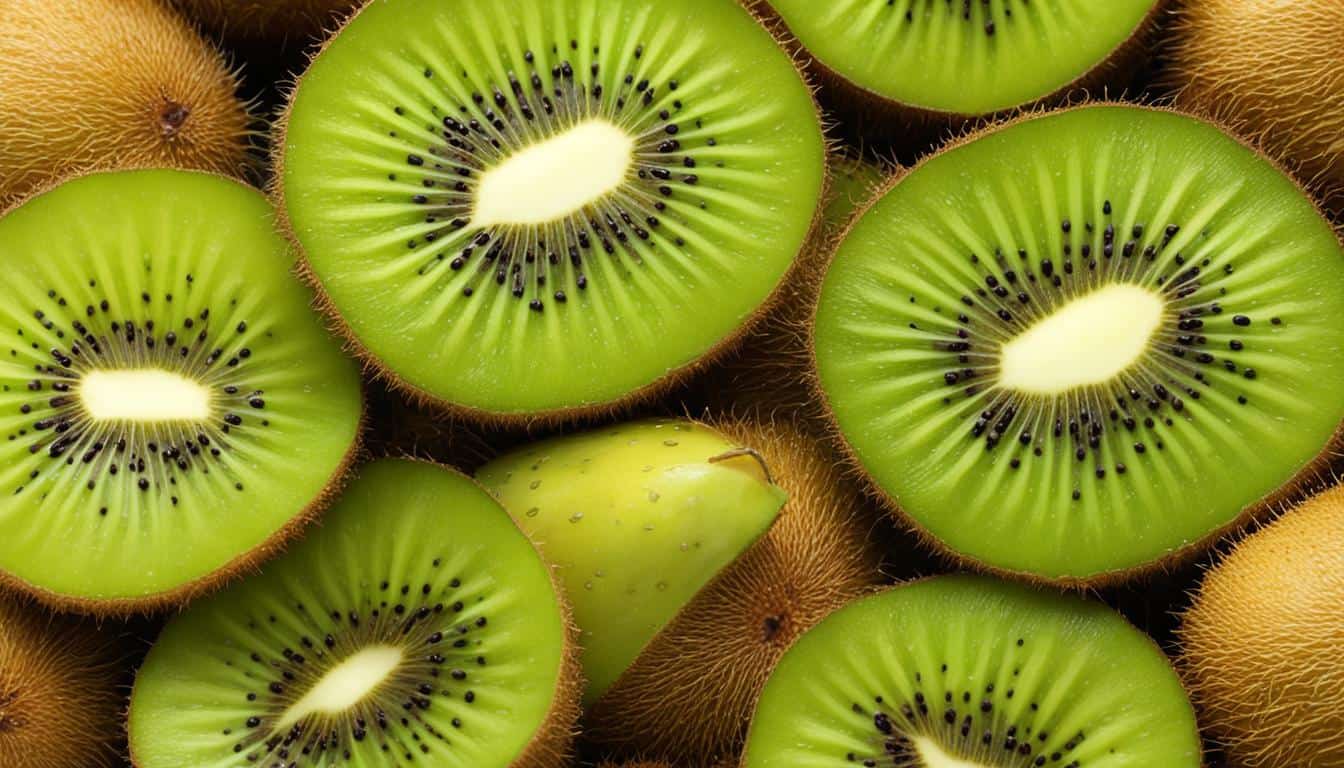



Leave a Reply